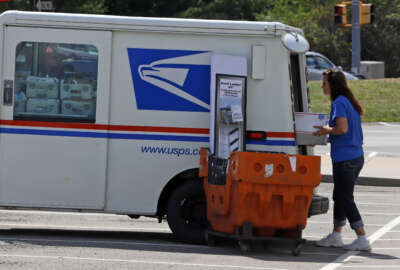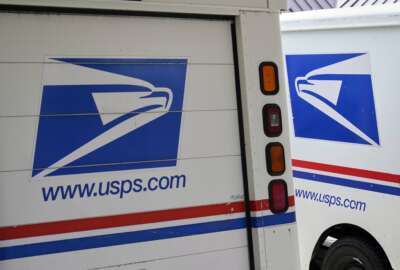

USPS will now follow a multiple-step acquisition process over the next 10-15 years, and expects to order smaller quantities of vehicles over shorter periods of...
Best listening experience is on Chrome, Firefox or Safari. Subscribe to Federal Drive’s daily audio interviews on Apple Podcasts or PodcastOne.
The Postal Service is scaling back the number of next-generation delivery vehicles it’s committed to purchasing, but is setting a higher bar for the minimum number of electric vehicles it will buy.
USPS announced Wednesday that it will, for now, only plan to buy the 50,000 next-generation delivery vehicles (NGDVs) it ordered in March, the minimum outlined in its contract with Oshkosh Defense. The agency, however, now ensures that no less than 50% of those custom-built vehicles will be electric vehicles.
The agency, in its contract award to Oshkosh Defense, expected to purchase up to 165,000 next-generation vehicles, and committed to making electric vehicles comprise at least 10% of its next-generation fleet.
The agency, in a notice expected to be published in the Federal Register on Thursday, said its higher commitment to electric vehicles “reflects the favorable cost-benefit impacts expected from the changes to both our operational strategy and our acquisition planning horizon.”
USPS will now follow a multiple-step acquisition process over the next 10-15 years, and expects to order smaller quantities of vehicles over shorter periods of time, compared to its 10-year contract with Oshkosh Defense.
To replace its aging vehicle fleet more immediately, USPS plans to purchase 34,500 commercial off-the-shelf vehicles over a two-year period.
USPS expects at least 40% of the 84,500 total vehicles it’s now forecasted to purchase — the 50,000 next-generation delivery vehicles, plus the 34,500 commercial off-the-shelf vehicles — will be electric.
USPS said its new vehicle fleet strategy allows it to be “more responsive to our evolving operational strategy, technology improvements, and changing market conditions,” including an expected increase in the availability of electric vehicles in the coming years.
“The Postal Service anticipates evaluating and procuring vehicles over shorter time periods to be more responsive to its evolving operational strategy, technology improvements, and changing market conditions, including the expected increased availability of BEV options in the future,” USPS wrote in the Federal Register notice.
USPS plans to assess the environmental impact of additional vehicle procurements on an as-needed basis, and will document those findings in supplements to its Final Environmental Impact Statement.
The agency announced last month that plans to consolidate its facilities across its network may create an opportunity to expand the number of electric vehicles in its next-generation fleet.
Postmaster General Louis DeJoy said last month he’s committed to working with Congress to buy more electric vehicles where it makes sense, and based on how many USPS can afford to buy with limited capital investment dollars.
Lawmakers have pressured USPS to purchase more electric vehicles than it originally expected, and have introduced several measures that would give the largely self-funded agency millions of dollars in order to afford more electric vehicles.
House Oversight and Reform Committee Chairwoman (D-N.Y.) praised USPS’s decision to more than double its initial purchase of EVs.
“Our Postal Service fleet of the future must be clean, affordable, and electric. This is the fleet that the American people deserve. I am pleased by this progress, but I will continue to fight for the Postal Service fleet to fully transition to electric vehicles,” Maloney said in a statement.
Senate Homeland Security and Governmental Affairs Committee Chairman Gary Peters (D-Mich.) also applauded the USPS’s decision to prioritize electric vehicles.
“Electric vehicles are the future of the automotive industry and that is why I have been pressing the Postal Service to purchase more of them as they continue to add more Next Generation Delivery Vehicles and other vehicles to their fleet,” Peters said.
DeJoy has repeatedly said USPS will buy more electric vehicles than what it can afford on its own, if Congress puts up the money, but that his biggest priority is replacing the agency’s aging fleet of vehicles, many of which are well past their expected lifespan.
“I need to get vehicles, and we’ll explore electric vehicles as it makes financial sense,” he said. “There will be a lot of politicians saying they forced us into this. Not so! This is going to be an ongoing financial analysis, and where it applies and where we can accommodate, we’re going to do it, just like I said from the beginning,” DeJoy said June 2 at a Reuters supply chain event in Chicago.
USPS is accepting public comments on its latest fleet acquisition plans through Aug. 15. The agency is also hosting a virtual public hearing on its new fleet plans on Aug. 8.
Over a two-year period, USPS will buy up to 20,000 left-hand drive commercial vehicles, including as many electric vehicles “as are commercially available and consistent with our delivery profile.” The agency will also purchase up to 14,500 right-hand drive, gasoline-powered vehicles.
“To be clear, the Postal Service anticipates that because of our critical and immediate need for delivery vehicles to fulfill our universal service mission, and the limitations on the current market availability for [battery electric vehicles] that can support our daily requirement to deliver to 163 million addresses six (and sometimes seven) days per week, it will be necessary for us to procure some [internal combustion engine] vehicles,” USPS wrote.
USPS also anticipates needing to make a “significant investment” in the repair of over 50,000 aging Long Life Vehicles and Flexible-Fuel Vehicles each year to continue extending their longevity, “despite the significant operational risk, considerable maintenance costs, and the higher emissions of greenhouse gases and other air pollutants when compared to more modern vehicles.”
“This activity will be necessary because of our universal service mission and our inability to acquire sufficient quantities of modern vehicles in the current market (irrespective of the type of drive train) to replace our delivery fleet,” USPS wrote.
Next-generation delivery vehicles are expected to hit delivery routes in late 2023.
The Postal Service’s earlier electric vehicle commitments also led to recent legal challenges.
California’s attorney general in April led 15 other states in a lawsuit to prevent USPS from taking any further action under its next-generation delivery vehicle contract, until it conducts a more in-depth environmental review.
Environmental groups and a major automotive union also filed lawsuits challenging the environmental impact of the USPS next-generation fleet.
Copyright © 2025 Federal News Network. All rights reserved. This website is not intended for users located within the European Economic Area.
Jory Heckman is a reporter at Federal News Network covering U.S. Postal Service, IRS, big data and technology issues.
Follow @jheckmanWFED


